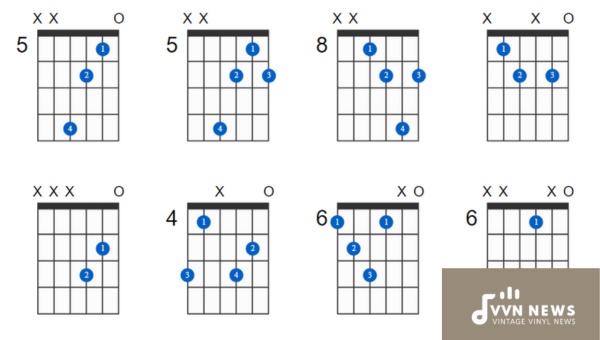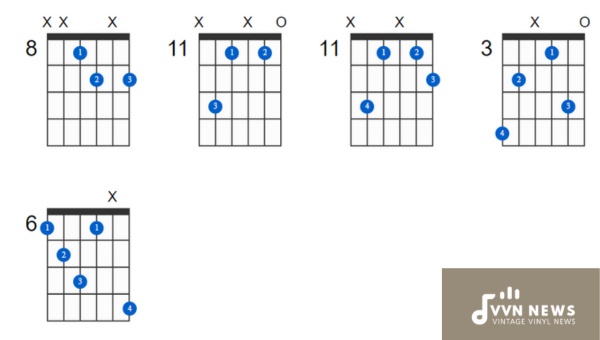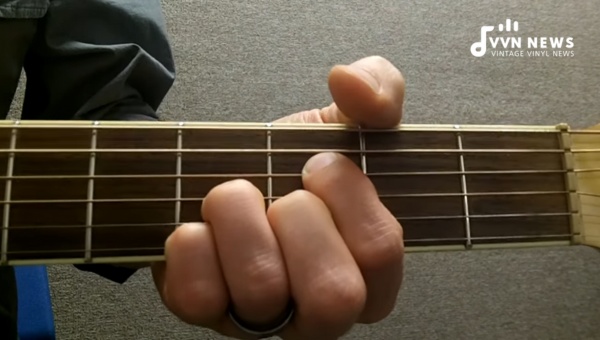Music is an intricate language that communicates straight to the soul.
One element that aids in this magical communication is the chord, a group of three or more notes played simultaneously.
Today, I want to share some insights on a particular chord: the B flat diminished triad.
Truly, something is enchanting about a B flat diminished triad, as it holds a significant place in the world of music composition and arrangement.
This seemingly simple triad possesses surprising depth and beauty, creating profound musical moments for both listeners and players alike.
Don’t let its simplicity fool you; within this humble chord lies a universe of sound waiting to be explored.
The Basics of B Flat Diminished Triad
The world of music theory is filled with a myriad of chords and harmonies that add depth and complexity to musical compositions.
One such chord, the B flat diminished triad, holds a unique place in this vast landscape.
In this section, we will delve into the fundamentals of triads, define the B flat diminished triad, and explore its components.
What is a Triad?
A triad is a three-note chord consisting of a root note, a third interval above the root, and a fifth interval above the root.
These three notes create harmonic tensions and resolutions that form the basis for melody and harmony in music.
Triads are essential building blocks in both Western classical music and various contemporary genres.
Defining the B Flat Diminished Triad
The B flat diminished triad is one specific type of triad that follows a distinct pattern.
It consists of three notes: B flat as the root note (represented by “B♭”), D♭ (the minor third), and F♭ (the diminished fifth).
The term “diminished” refers to the lowered or flattened fifth interval present in this chord.
Components of a B Flat Diminished Triad
- Root Note (B♭): The root note serves as the foundation for any chord and determines its tonal center or key. In the case of the B flat diminished triad, “B♭” represents this fundamental pitch.
- Minor Third (D♭): The minor third is an interval consisting of three half steps or semitones above the root note. For our case, D♭ is precisely this interval above B♭.
- Diminished Fifth (F♭): The diminished fifth has six half steps or semitones above the root note. In our example, F♭ has situated this interval above B♭.
The individual components of the B flat diminished triad is crucial for comprehending its role and usage within broader musical contexts.
By recognizing the distinct intervals that make up this chord, musicians can construct harmonies that convey specific emotions and create interesting melodic variations.
To solidify your memorization, let’s summarize the structure of the B flat diminished triad:
- Root Note: B♭
- Minor Third: D♭
- Diminished Fifth: F♭
By keeping these three components in mind, you will be better equipped to recognize and utilize the B flat diminished triad in your musical endeavors.
In the upcoming sections, we will explore its significance, inversions, and how to play it on different instruments.
Also Read: F Sharp Diminished Triad [Boost Your Musical Finesse Today]
Structure of the B Flat Diminished Triad

When we analyze the structure of the B flat diminished triad, we find three fundamental components that give it its unique sound: the root note, the minor third, and the diminished fifth.
Each of these elements contributes to the overall character and tonality of the chord.
A. The Root Note
The root note serves as the foundation for any chord. In the case of the B flat diminished triad, the root note is B flat.
It provides a sense of stability and grounds the chord in its tonal center.
The root note forms a strong base from which other intervals within the chord create tension and resolution.
B. The Minor Third
Moving up from the root note, we encounter the minor third interval. In this case, it is D flat (also known as C sharp).
This interval creates a sense of dissonance and adds color to the chord’s overall sound.
The minor third interval distinguishes a diminished triad from other types of triads by contributing to its unique quality.
C. The Diminished Fifth
The final component that completes the structure of a diminished triad is the diminished fifth, also known as the tritone or flatted fifth.
To form a B flat diminished triad, we need to add an F (which is a tritone distance from B flat) into the mix.
This interval creates an unstable and unresolved feeling that gives this type of chord its distinct character.
The combination of these three elements creates an unmistakable sonic profile for the B flat diminished triad – equal parts tension and consonance, dissonance, and resolution.
These intervals work together is crucial when composing or analyzing music that incorporates this chord type.
Also Read: A Major Triad [Master This Building Block Of Music]
Why is B Flat Diminished Triad Significant?
When it comes to music theory, the b flat diminished triad holds significant importance due to its unique sound and versatile applications.
Its significance can greatly enhance your ability to compose and appreciate music in a wide range of genres.
Here are a few reasons why the b flat diminished triad is a chord worth exploring:
Diminished Chords:
- The b flat diminished triad belongs to a family of chords known as diminished chords.
- Diminished chords create tension and dissonance, adding depth and complexity to musical compositions.
- They are often used in jazz, classical, and modern music genres to create harmonic tension before resolving to more stable chords.
Chromatic Movement:
- The b flat diminished triad facilitates smooth chromatic movement within a piece of music.
- It adds richness and texture by connecting different tonal centers or key areas seamlessly.
- This chromatic movement adds interest and can create unexpected twists in melodies.
Modulation Tool:
- The b flat diminished triad serves as an effective modulation tool that allows musicians to smoothly transition from one key to another.
- By using this chord, composers can explore various harmonic possibilities and introduce new tonalities without abrupt changes.
Passing Chord:
- In jazz improvisation, the b flat diminished triad often functions as a passing chord.
- It adds color and interest to melodic lines while connecting two more stable chords.
- This passing function contributes to the fluidity and momentum of improvised solos.
Also Read: A Flat Major Triad [Simplify Complex Music Theory Today]
Enhanced Harmonic Vocabulary:
- Incorporating the b flat diminished triad into your musical compositions expands your harmonic vocabulary.
- It allows you to experiment with unique progressions that unleash creativity and evoke specific emotions in listeners.
Foundational Recognition:
- A solid knowledge of the b flat diminished triad equips you with essential knowledge for exploring more complex and advanced musical concepts.
- It serves as a stepping stone to comprehending advanced chord substitutions and extended harmonies.
The b flat diminished triad holds immense significance in music theory and composition.
Its unique characteristics, such as dissonance, chromatic movement, modulation capabilities, and passing functionality, contribute to its versatility across different musical genres.
Inversions in B Flat Diminished Triads

In music theory, inversions refer to different arrangements of notes within a chord.
When it comes to the B flat diminished triad, inversions are key to unlocking its full potential and exploring its rich harmonic possibilities.
In this section of the ultimate theory guide, we will explore the concept of inversions in B flat diminished triads and how they can be used effectively in your musical compositions.
What are Inversions?
Inversions occur when the order of the notes in a chord is rearranged so that a note other than the root becomes the lowest note.
This creates different voicings and textures within a chord, adding variety and depth to your compositions.
Inversions of B Flat Diminished Triads
The B flat diminished triad consists of three notes: B flat (the root), D flat (the minor third), and F flat (the diminished fifth).
By rearranging these notes in different orders, we can create three possible inversions of the B flat diminished triad:
First inversion: D flat – F flat – B flat
- The first inversion occurs when we take the note D flat and make it the lowest note in the chord.
- This creates a unique sound where the minor third becomes the bass note.
Second inversion: F flat – B flat – D flat
- The second inversion takes the note F flat and places it at the lowest position within the chord.
- This inversion highlights the diminished fifth as the bass note, which creates tension and dissonance.
Third inversion: B flat – D flat – F flat
- The third inversion keeps the original order of notes but places them in higher octaves.
- It adds a sense of release and resolution after using one or both of the previous inversions.
[[Also Read: G Major Triad [Revolutionize Your Music Knowledge Today]
Applications and Usage
Inversions in B flat diminished triads allow for greater versatility and creativity in your compositions.
Each inversion has a unique character and can be used to evoke different emotions or create specific musical effects.
- First inversions are often used as passing chords, adding smooth transitions between other chords.
- Second inversions can create tension or be used for their dissonant qualities.
- Third inversions provide resolution and stability and are commonly found at the end of phrases or sections.
By experimenting with different inversions and their placements in your compositions, you can add complexity and interest to your music.
Inversions in B flat diminished triads is an essential aspect of music theory that opens up a world of possibilities for composition and arrangement.
By taking the time to explore each inversion, you can harness the unique sounds and effects they offer to enhance your musical creations. So go ahead, experiment, and have fun incorporating these inversions into your compositions!
How to Play the B Flat Diminished Triad on Different Instruments?
Knowing how to play the B flat diminished triad on different instruments is essential for musicians looking to incorporate this chord into their playing.
Here’s a step-by-step guide on how to play the B flat diminished triad on piano and keyboards, guitar, and violin:
A: On Piano and Keyboards
- Find the B flat key on your keyboard. It is located three white keys to the left of a set of two black keys.
- Play the root note, which is B flat. Press down on the corresponding key.
- Place your middle finger on the D key, which is two white keys above the root note.
- Use your pinky finger to reach the F key, which is one white key above the D key.
- Play all three notes simultaneously to sound out the full B flat diminished triad.
B: On the Guitar
- Start by finding a reference point on your guitar neck for playing a B flat note (6th fret of low E string).
- Place your index finger on the 6th fret of the low E string to play the root note, which is B flat.
- Position your ring finger on the 8th fret of A string (two frets above), playing D.
- Place your pinky finger on the 9th fret of the D string (one fret above), playing F.
- Strum all three strings together from low E to high E for a complete b flat diminished triad.
C: On Violin
- Position your first finger over both A and E strings at their second (B) half-step marks to create a flattened tone.
- Place your second finger over both D and G strings at their second (B) half-step marks, creating another flattened tone.
- Press down on all four strings simultaneously using light pressure to maintain a clear and accurate sound.
- Bow across all four strings in a smooth, fluid motion to produce the full B flat diminished triad.
Remember to practice these finger positions and movements slowly at first and gradually increase your speed as you become more comfortable with playing the B flat diminished triad on each instrument.
It’s essential to develop muscle memory and accuracy so that you can incorporate this chord effortlessly into your playing.
As with any skill, regular practice is key. Spend dedicated time each day focusing on playing the B flat diminished triad in different inversions and progressions across various octaves on your chosen instrument.
With time and patience, you’ll become proficient in incorporating the B flat diminished triad into your musical repertoire, adding depth and complexity to your compositions or improvisations.
Also Read: E Major Triad [Master This Staple Of Music Composition]
FAQs about the B Flat Diminished Triad
What is the purpose of a diminished triad in music theory?
The diminished triad adds a distinct sense of tension and instability to music, making it perfect for creating suspenseful and haunting melodies or harmonies.
Can I use the B flat diminished triad in any musical genre?
Absolutely! The B flat diminished triad is incredibly versatile and can be used in various genres, including classical, jazz, rock, and pop.
How do I form the B flat diminished triad?
To form the B flat diminished triad, you start with the root note (B flat), then add the minor third interval (D flat), followed by the diminished fifth interval (F).
Are there different inversions of the B flat diminished triad?
Yes, there are three inversions of the B flat diminished triad: first inversion (D flat – F – B flat), second inversion (F – B flat – D flat), and third inversion (B flat – D flat – F).
Can you recommend songs that feature the B flat diminished triad?
Certainly! Songs like “Blackbird” by The Beatles and “Strange Fruit” by Billie Holiday showcase creative uses of the B Flat diminished triad, giving them a unique and unforgettable sound.
Conclusion
In conclusion, the B flat diminished triad is a powerful chord that can add depth and complexity to your musical compositions.
With its structure and various inversions, you can utilize this chord in a variety of musical genres.
Whether you’re playing the piano, guitar, violin, or any other instrument, the B flat diminished triad offers endless opportunities for creative expression.
So go ahead and experiment with this unique chord and unlock the full potential of your musical compositions. Happy playing!








